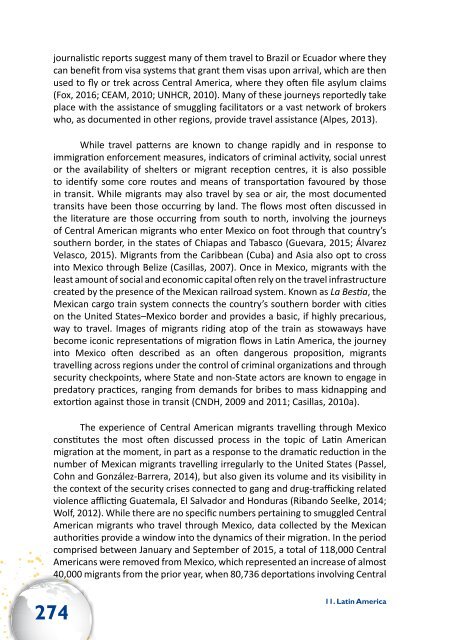Migrant Smuggling Data and Research
zgw9fv2
zgw9fv2
You also want an ePaper? Increase the reach of your titles
YUMPU automatically turns print PDFs into web optimized ePapers that Google loves.
journalistic reports suggest many of them travel to Brazil or Ecuador where they<br />
can benefit from visa systems that grant them visas upon arrival, which are then<br />
used to fly or trek across Central America, where they often file asylum claims<br />
(Fox, 2016; CEAM, 2010; UNHCR, 2010). Many of these journeys reportedly take<br />
place with the assistance of smuggling facilitators or a vast network of brokers<br />
who, as documented in other regions, provide travel assistance (Alpes, 2013).<br />
While travel patterns are known to change rapidly <strong>and</strong> in response to<br />
immigration enforcement measures, indicators of criminal activity, social unrest<br />
or the availability of shelters or migrant reception centres, it is also possible<br />
to identify some core routes <strong>and</strong> means of transportation favoured by those<br />
in transit. While migrants may also travel by sea or air, the most documented<br />
transits have been those occurring by l<strong>and</strong>. The flows most often discussed in<br />
the literature are those occurring from south to north, involving the journeys<br />
of Central American migrants who enter Mexico on foot through that country’s<br />
southern border, in the states of Chiapas <strong>and</strong> Tabasco (Guevara, 2015; Álvarez<br />
Velasco, 2015). <strong>Migrant</strong>s from the Caribbean (Cuba) <strong>and</strong> Asia also opt to cross<br />
into Mexico through Belize (Casillas, 2007). Once in Mexico, migrants with the<br />
least amount of social <strong>and</strong> economic capital often rely on the travel infrastructure<br />
created by the presence of the Mexican railroad system. Known as La Bestia, the<br />
Mexican cargo train system connects the country’s southern border with cities<br />
on the United States–Mexico border <strong>and</strong> provides a basic, if highly precarious,<br />
way to travel. Images of migrants riding atop of the train as stowaways have<br />
become iconic representations of migration flows in Latin America, the journey<br />
into Mexico often described as an often dangerous proposition, migrants<br />
travelling across regions under the control of criminal organizations <strong>and</strong> through<br />
security checkpoints, where State <strong>and</strong> non-State actors are known to engage in<br />
predatory practices, ranging from dem<strong>and</strong>s for bribes to mass kidnapping <strong>and</strong><br />
extortion against those in transit (CNDH, 2009 <strong>and</strong> 2011; Casillas, 2010a).<br />
The experience of Central American migrants travelling through Mexico<br />
constitutes the most often discussed process in the topic of Latin American<br />
migration at the moment, in part as a response to the dramatic reduction in the<br />
number of Mexican migrants travelling irregularly to the United States (Passel,<br />
Cohn <strong>and</strong> González-Barrera, 2014), but also given its volume <strong>and</strong> its visibility in<br />
the context of the security crises connected to gang <strong>and</strong> drug-trafficking related<br />
violence afflicting Guatemala, El Salvador <strong>and</strong> Honduras (Rib<strong>and</strong>o Seelke, 2014;<br />
Wolf, 2012). While there are no specific numbers pertaining to smuggled Central<br />
American migrants who travel through Mexico, data collected by the Mexican<br />
authorities provide a window into the dynamics of their migration. In the period<br />
comprised between January <strong>and</strong> September of 2015, a total of 118,000 Central<br />
Americans were removed from Mexico, which represented an increase of almost<br />
40,000 migrants from the prior year, when 80,736 deportations involving Central<br />
274<br />
11. Latin America
















